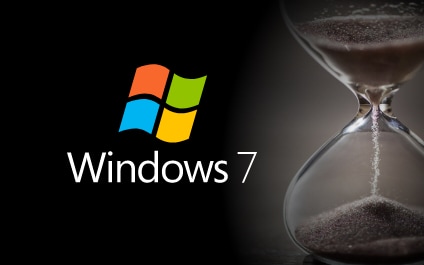
On January 14, 2020, Microsoft ended support for Windows 7. As a result, Windows End of Life is now upon us. What does End of Life mean? Well, it doesn't mean your computer will stop working. Further, it doesn't mean that Windows 7 will stop functioning either. What it does mean is that if Windows 7 fails, crashes, or becomes infested with bugs and malware, that Microsoft can't provide any support.
For seasoned Microsoft users, End of Life is nothing new. Windows 7 made its debut on July 22, 2009. As a result, this operating system (OS) is over a decade old. There have been many technological changes since then, especially with connection speeds, cloud computing, AI, and more. In simple terms: Windows 7 is no longer supported by Microsoft.
Invariably, it makes sense for Microsoft to focus their resources on support for their more recent OS. Think of it this way: Microsoft has had so many iterations of their OS and they work wonderfully for their time. But, it wouldn't make sense to divide their time between dinosaurs and the current OS which is made to work with contemporary systems and technologies.
Now, if you have already upgraded to Windows 10 - then your systems should be fine. If not, please carefully read the FAQ guide below.
Can you still purchase support and updates from Microsoft?
Yes, you can. If your system has either hardware or software incompatibilities with Microsoft 10, then Microsoft does offer the option to purchase Extended Security Update (ESU) licenses for one year at a time, per computer. In fact, they will be available up until 2023. The ESU licenses cost between $25 to $200 per workstation depending on which version of Windows 7 you are running. There is one caveat: Only SMBs, and companies who already have volume licensing agreements, are eligible to purchase the ESUs.
It's crucial to note that just because Windows 7 still works, doesn't mean you should use it. End of Life also means that Microsoft will no longer patch the OS for any new security issues or viruses. Your organization is then ripe for cyber security threats. Instead, Microsoft has instructed its customers to migrate to Windows 10. If you do so, then you can continue to enjoy the Microsoft support you have grown accustomed to.
Upgrading is easy
The good news is Microsoft made the transition from Windows 7 to Windows 10 positively seamless. In fact, you will have little-to-no disruption. Further, a majority of the programs you are already used to using will be updates. And, you can more than likely keep all your files. If that's not enough, the user interface and layout of Windows 10 shares many similarities with Windows 7. It won't feel foreign at all. But, upgrading to Windows 10 is not mandatory. For security reasons, and functionality, it is highly recommended to do so. Yet, you have to make the final decision.
What happens if I don't upgrade to Windows 10?
For starters, as mentioned earlier, you will leave your systems highly vulnerable to data breaches and more. In fact, Microsoft has already sent out a security advisory about the Zero-Day exploit, also known as CVE-2020-0674. It causes a memory corruption issue and lets remote attackers run whatever code they want.
The Zero-Day vulnerability can be further exploited if a threat actor sends an email luring you to a malicious website through your Windows 7 browser. From that point, the cyber criminal could install programs and even gain full user rights to your OS.
And, this vulnerability is unpatched. Further, hackers timed the vulnerability right at End of Life for Windows 7 so that they could gain access to thousands of devices and workstations.
Cyber thieves are well-aware that there will be some remnants still using Windows 7, and they will specifically target this OS because they already know it is in the End of Life stage. Moreover, Windows 10 just has way better security features than Windows 7 ever had. Windows 10 is designed for the modern threat landscape, while Windows 7 worked for the time when it was first launched.
What steps should I take to upgrade?
To deal with any potential issues, you should contact us to provide you with our services and a seamless upgrade. If you decide to take the self-service route, you will need to purchase a Windows 10 license as well as all associated installations.
Sounds pretty straightforward, but there are unseen obstacles which may pop up when you least expect it. In other scenarios, you might have to reconfigure your security software, printers, scanners, and any other devices installed on your computer.
I have Windows 8 or Windows 8.1 do I need to upgrade to windows 10?
Well, Microsoft's mainstream support ended for Windows 8.1 on January 9th, 2018. Microsoft is truly focusing on Windows 10, which is why it makes the most sense to upgrade now. Not only will you get to continue using the OS, but you'll still have the ability to use Microsoft's mainstream support. Plus, Windows 10 will be compatible with the latest technologies to date.
And, Windows 10 has Secure Boot, just like 8.1. What is Secure Boot? It is a feature that requires any code that runs when you start your OS to be signed either by the hardware maker or Microsoft. But, there is a difference. With Windows 8.1., you could bypass Secure Boot. In Windows 10, it comes with a feature where Secure Boot cannot be bypassed.
What if I purchased a new computer?
This might not be a bad idea as the typical lifespan of a computer is around three years. After that time frame, it simply is unable to efficiently run the latest software and technologies. In addition, if you do purchase a new computer it's critical to ensure it is compatible with your workstations - this would be the Windows 10 Pro Edition. For example, the Windows 10 Home edition would not be compatible with your business networks.
Final thought
Now that you have learned about Windows 7 End of Life, it is truly time to upgrade to Windows 10. Of course, you don't have to, but with all the improved security features and functions why wouldn't you want to?
Reach out to us and see how we can help and ensure that your network is protected and running at full strength. Please make sure you have your Windows 10 and Cyber Security upgrades completed by now! Call us at 201-402-1900 or email us at Sales@krsit.com

